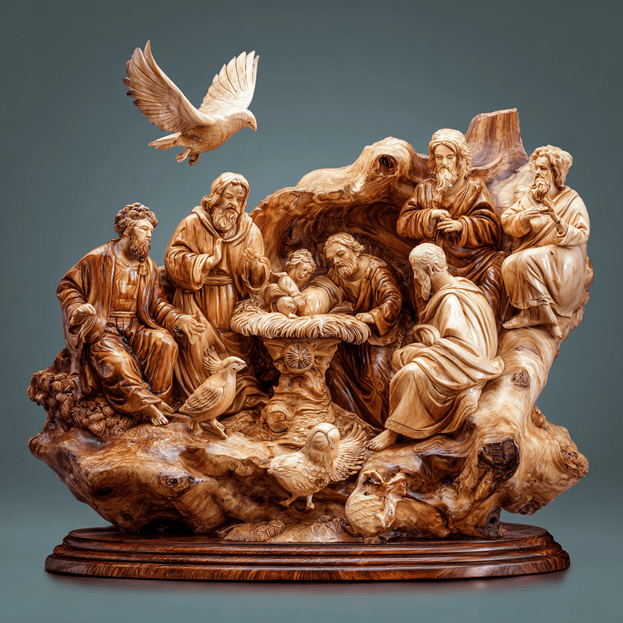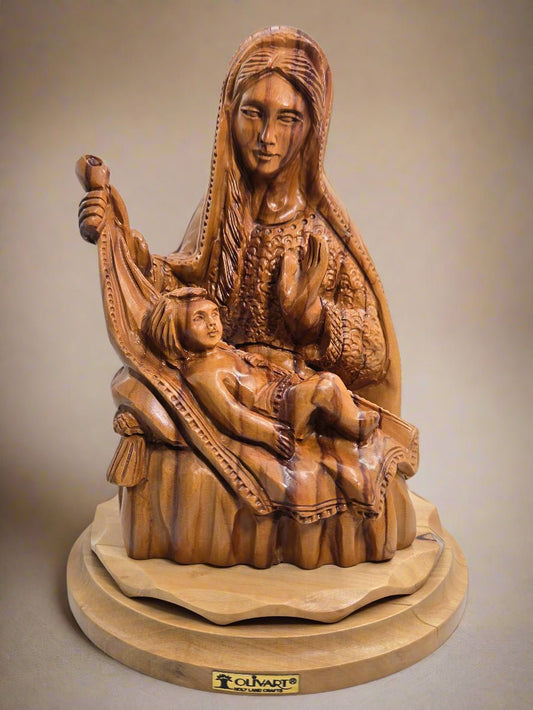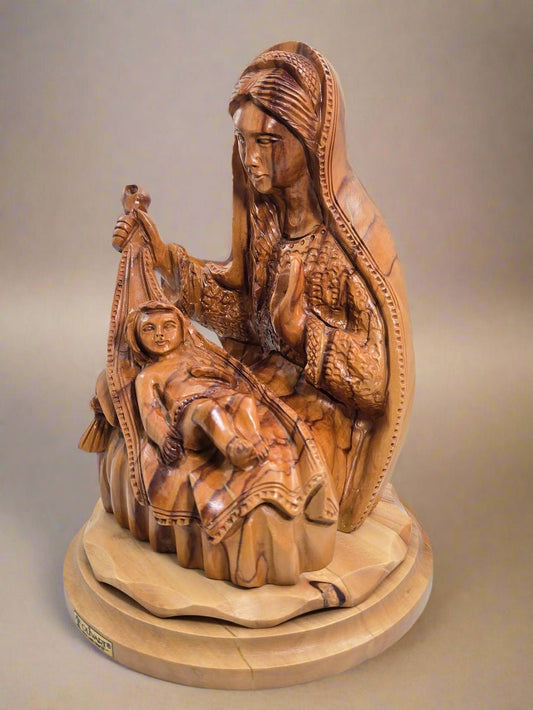
The Sacred Olive Trees of the Holy Land: A Living Heritage
Across the ancient hills of Jerusalem, Bethlehem, and Nazareth, olive trees stand as silent witnesses to over two thousand years of Christian history. Their gnarled trunks and silvery leaves have weathered empires, witnessed prayers, and provided the raw material for sacred art that connects believers worldwide to the very soil where Christ walked.
The Biblical Significance of the Olive Tree
The olive tree holds a special place in Christian faith and biblical history. From the very beginning, this remarkable tree has been a symbol of peace, hope, and divine blessing. When Noah's dove returned to the ark carrying an olive branch, it signaled God's peace with humanity after the flood. Christ himself prayed among the olive trees in the Garden of Gethsemane before his crucifixion, making these ancient groves forever sacred to Christians.
Throughout the Old Testament, olive oil was used to anoint kings, priests, and prophets, marking them as chosen by God. The word "Messiah" itself means "the anointed one," connecting Jesus directly to the olive tree's sacred oil. This rich biblical heritage makes olive wood particularly meaningful for creating religious objects and devotional items.
The olive tree's longevity also speaks to the enduring nature of faith. Some olive trees in the Holy Land are believed to be over a thousand years old, their roots reaching deep into the same soil that supported the trees of Christ's time. When we hold objects made from this wood, we touch a living connection to biblical history.
A Craft Born from Faith
The tradition of carving olive wood in the Holy Land began in the earliest centuries of Christianity. Local Christian families, many descended from the first believers, developed the skills to transform olive branches into beautiful sacred objects. What started as simple crosses and prayer beads for pilgrims has evolved into a sophisticated art form passed down through generations.
These early Christian artisans understood that their work was more than mere craftsmanship—it was a form of prayer and devotion. Each piece they created would accompany someone in their spiritual journey, making the act of carving itself a sacred responsibility. This understanding continues today in the workshops of Bethlehem and Jerusalem.
The craft flourished as pilgrims from around the world visited the Holy Land, seeking tangible reminders of their journey to the places where Christ lived and taught. A small olive wood cross or rosary became a treasured connection to the Holy Land, carrying with it the prayers and blessings of the artisans who created it.
The Unique Beauty of Olive Wood
Olive wood possesses characteristics that make it ideal for creating sacred objects. The wood is dense and durable, yet warm to the touch—qualities that enhance the prayer experience. Its natural grain patterns are unlike any other wood, with swirling lines that seem to flow like rivers of light through the golden honey to deep amber colored surface.
No two pieces of olive wood are identical. Each tree, each branch, even each section of wood has its own unique pattern and coloring. This means that every olive wood cross, rosary, or nativity set is truly one-of-a-kind, reflecting the individual character of the tree from which it came.
The wood ages beautifully, developing a deeper patina over time. With gentle handling and care, olive wood objects become more beautiful as they age, making them perfect heirlooms to pass down through generations. The natural oils in the wood help preserve it, and the smooth finish achieved by skilled artisans makes each piece pleasant to hold during prayer and meditation.
Traditional Craftsmanship Techniques
Creating sacred objects from olive wood requires exceptional skill and patience. The process begins with the careful selection of wood from pruned olive branches. Artisans must understand the wood's grain patterns, moisture content, and natural stresses to work with it effectively.
Each piece is individually shaped using traditional hand tools. The artisan must work slowly and carefully, following the natural grain of the wood to avoid splitting or cracking. This process cannot be rushed—the wood itself dictates the pace of the work.
The carving process requires years of experience to master. Artisans learn to read the wood, understanding how it will respond to different cuts and techniques. They develop an intuitive sense of how to bring out the wood's natural beauty while creating the desired shape and form.
After carving, each piece is carefully sanded and polished by hand. This process can take hours for a single item, as the artisan works through progressively finer grades of sandpaper to achieve the smooth, lustrous finish that makes olive wood so pleasant to touch.
Types of Olive Wood Sacred Objects
The versatility of olive wood allows artisans to create a wide variety of religious items, each serving different aspects of Christian devotion and worship.
Crosses and Crucifixes
Olive wood crosses range from simple, elegant designs to elaborate crucifixes with detailed carving. The natural beauty of the wood enhances the spiritual significance of the cross, making it a powerful symbol for personal devotion or home display.
Rosaries and Prayer Beads
Olive wood rosaries are particularly treasured for their smooth feel and beautiful appearance. Each bead is individually shaped and polished, creating a tactile experience that enhances prayer and meditation. The natural variations in the wood ensure that each rosary is unique.
Nativity Sets
Perhaps no other religious art form captures the Christmas story as beautifully as an olive wood nativity set. Artisans carve each figure with careful attention to detail, from the Holy Family to the shepherds and wise men. These sets become centerpieces of Christmas celebration and family tradition.
Religious Statues and Icons
Skilled artisans create beautiful representations of Jesus, Mary, and the saints from olive wood. These pieces serve as focal points for prayer and meditation, bringing the sacred into everyday living spaces.
Home Décor and Ornaments
Olive wood religious ornaments and decorative items allow believers to incorporate their faith into their home environment. From wall crosses to decorative angels, these pieces serve as constant reminders of God's presence.
Keychains and Small Gifts
Simple olive wood crosses and religious symbols make meaningful gifts for confirmations, baptisms, and other religious occasions. Despite their small size, these items carry the same spiritual significance as larger pieces.
The Artisan Families of the Holy Land
Behind every olive wood sacred object is a story of faith, tradition, and perseverance. The Christian artisan families of the Holy Land represent an unbroken chain of faith stretching back to the earliest days of Christianity. These families have maintained their presence in Jerusalem and Bethlehem despite centuries of political upheaval and economic challenges.
Many of these workshops are family enterprises where skills are passed from parent to child. Fathers teach sons the secrets of reading wood grain and using traditional tools. Mothers often handle the finishing work, polishing and assembling the final pieces. Children grow up surrounded by the sights, sounds, and smells of the workshop, naturally absorbing the techniques and traditions.
The rhythm of work in these workshops reflects the rhythm of prayer—patient, meditative, and reverent. Artisans often pray while they work, blessing each piece as it takes shape. This spiritual dimension adds an intangible but very real quality to authentic Holy Land olive wood crafts.
These families face unique challenges in maintaining their traditional way of life. Economic pressures, political uncertainties, and the general decline of traditional crafts threaten the continuation of skills that have been preserved for generations. Many young people emigrate in search of better opportunities, leaving behind elderly artisans who struggle to pass on their knowledge.
Sustainable Harvesting and Environmental Stewardship
One of the most important aspects of authentic olive wood crafts is the sustainable way the wood is harvested. Contrary to what some might think, olive trees are not cut down to provide wood for carving. Instead, artisans use wood from the regular pruning that olive trees require to remain healthy and productive.
Olive trees need annual pruning to remove old, diseased, or overcrowded branches. This pruning is essential for the tree's health—it allows sunlight to reach all parts of the tree, improves air circulation, and encourages new growth. The pruned branches, which would otherwise be discarded or burned, provide the raw material for sacred crafts.
This sustainable approach means that the ancient olive trees of the Holy Land continue to thrive while also providing the materials for beautiful religious objects. Some of these trees are hundreds or even thousands of years old, and the sustainable harvesting practices ensure they will continue to flourish for future generations.
The environmental stewardship practiced by Holy Land artisans reflects a deep theological understanding of humanity's role as caretakers of creation. By using what would otherwise be waste material, they demonstrate how human creativity can work in harmony with natural processes.
The Spiritual Significance of Olive Wood Objects
When believers hold an olive wood cross or pray with an olive wood rosary, they connect with something much deeper than beautiful craftsmanship. These objects carry within them the spiritual heritage of the Holy Land, the prayers of the artisans who created them, and the accumulated devotion of countless believers who have used similar objects in their spiritual journeys.
The tactile quality of olive wood enhances the prayer experience. The smooth, warm surface feels pleasant in the hands, while the natural grain patterns provide visual interest that can aid in meditation and contemplation. The knowledge that the wood comes from trees growing in the same soil where Christ walked adds a profound dimension to personal devotion.
Many believers report that praying with olive wood objects from the Holy Land deepens their sense of connection to the biblical narrative. The physical reality of holding something that grew in the land of the Bible makes the stories and teachings of Christianity feel more immediate and personal.
Preserving Christian Heritage in the Holy Land
Supporting authentic olive wood crafts serves a purpose far beyond acquiring beautiful religious objects. It helps preserve the Christian presence in the Holy Land and maintains traditions that might otherwise be lost to time and economic pressure.
The Christian population in the Holy Land has declined significantly over the past century due to various economic and political factors. Those who remain face unique challenges in maintaining their communities and traditions. The income from olive wood crafts provides essential support for Christian families, helping them maintain their presence in the land where Christianity was born.
When believers around the world choose authentic Holy Land olive wood crafts, they participate in preserving not just traditional skills but an entire way of life rooted in Christian faith and heritage. Each purchase helps sustain workshops, support families, and contribute to the continued Christian witness in the places most sacred to our faith.
The preservation of these traditions also maintains important cultural knowledge about traditional craftsmanship techniques, sustainable resource use, and the integration of faith with daily work. This knowledge represents centuries of accumulated wisdom that would be difficult or impossible to recover if lost.
Caring for Olive Wood Sacred Objects
Olive wood objects are designed to last for generations with proper care. The natural oils in the wood help preserve it, but a few simple practices will ensure that your olive wood sacred objects remain beautiful and functional for years to come.
Regular dusting with a soft, dry cloth will keep the surface clean and lustrous. Avoid using water or cleaning products, as these can damage the wood's natural finish. If the wood begins to look dry, a very small amount of natural oil (such as olive oil) applied with a soft cloth and then wiped clean can restore its natural beauty.
Store olive wood objects in a safe place where they won't be knocked over or damaged. Avoid exposing them to direct sunlight for extended periods, as this can cause the wood to fade or crack. With proper care, olive wood sacred objects will develop a beautiful patina over time, becoming more beautiful with age.
The Global Community of Faith
Olive wood sacred objects create connections that span continents and cultures. A rosary carved in Bethlehem might accompany prayers in a small church in rural America. A cross crafted in Jerusalem might hang in a home in Europe, serving as a daily reminder of faith and hope.
These connections form a global community of believers united not just by shared faith but by tangible objects that carry the prayers and blessings of the Holy Land. When Christians around the world pray with olive wood objects, they join their voices with the artisans who created them and with all the believers who have found meaning in these simple yet profound expressions of faith.
This global community also provides the economic support that allows Christian artisan families to continue their traditional way of life. The appreciation and support of believers worldwide helps ensure that these ancient traditions will continue for future generations.
A Living Testament to Faith
Olive wood sacred objects represent more than beautiful craftsmanship or meaningful symbols. They embody a living testament to the enduring power of faith, the importance of tradition, and the connection between the physical and spiritual worlds.
Each piece tells a story that begins with an ancient tree rooted in biblical soil, continues through the skilled hands of a faithful artisan, and finds its completion in the prayers and devotion of believers around the world. This story connects past and present, earth and heaven, tradition and innovation.
The olive trees of the Holy Land continue to grow, their branches reaching toward the sky as they have for millennia. The artisan families continue their work, preserving skills and traditions passed down through generations. And believers around the world continue to find meaning and inspiration in these simple yet profound expressions of faith.
To explore our collection of authentic olive wood sacred objects handcrafted by Christian families in the Holy Land, visit our olive wood crafts collection. Each piece is sustainably sourced from pruned olive branches and carries the prayers and blessings of the artisans who created it. Learn more about our commitment to environmental stewardship and supporting Christian heritage through our Protecting Trees initiative.


